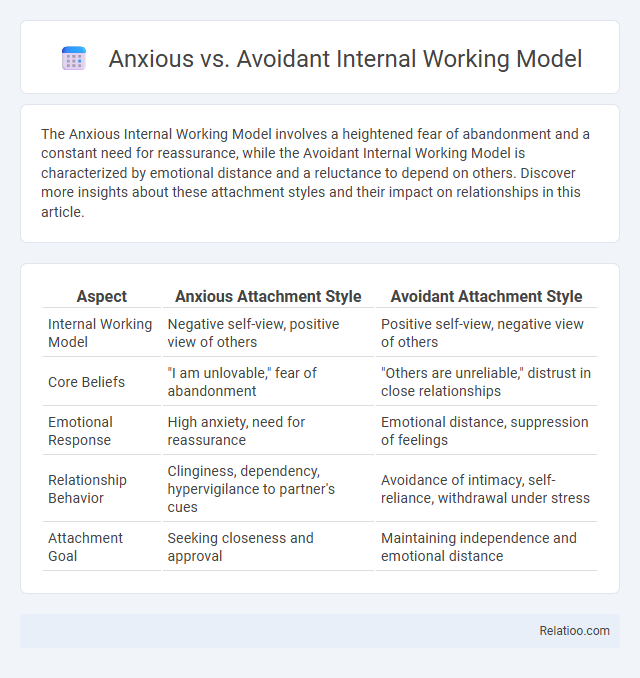The Anxious Internal Working Model involves a heightened fear of abandonment and a constant need for reassurance, while the Avoidant Internal Working Model is characterized by emotional distance and a reluctance to depend on others. Discover more insights about these attachment styles and their impact on relationships in this article.
Table of Comparison
| Aspect | Anxious Attachment Style | Avoidant Attachment Style |
|---|---|---|
| Internal Working Model | Negative self-view, positive view of others | Positive self-view, negative view of others |
| Core Beliefs | "I am unlovable," fear of abandonment | "Others are unreliable," distrust in close relationships |
| Emotional Response | High anxiety, need for reassurance | Emotional distance, suppression of feelings |
| Relationship Behavior | Clinginess, dependency, hypervigilance to partner's cues | Avoidance of intimacy, self-reliance, withdrawal under stress |
| Attachment Goal | Seeking closeness and approval | Maintaining independence and emotional distance |
Understanding Internal Working Models
Internal Working Models (IWMs) are cognitive frameworks formed from early attachment experiences, shaping expectations about self and others in relationships. Anxious IWMs often involve fear of abandonment and hypervigilance to relational threats, while Avoidant IWMs reflect discomfort with closeness and a tendency to suppress emotional needs. Understanding these variations in IWMs helps explain individual differences in attachment behaviors and emotional regulation within interpersonal dynamics.
Defining Anxious Attachment Patterns
Anxious attachment patterns in the internal working model are characterized by heightened sensitivity to rejection and a persistent fear of abandonment, leading to clingy or dependent behaviors in relationships. This contrasts with avoidant attachment, where individuals suppress emotional expression and maintain emotional distance to protect themselves from potential hurt. Understanding your anxious internal working model helps in recognizing these patterns and fostering healthier relational dynamics.
Defining Avoidant Attachment Patterns
Avoidant attachment patterns are characterized by a defensive strategy where individuals distance themselves emotionally to maintain independence and avoid intimacy. Your internal working model develops from early caregiver interactions, leading to expectations that others will be unavailable or rejecting. This contrasts with anxious attachment, where hypervigilance to relational cues and fear of abandonment dominate the internal working model.
Key Differences Between Anxious and Avoidant Models
The Anxious Internal Working Model centers on a heightened sensitivity to rejection and a strong desire for closeness, while the Avoidant Internal Working Model prioritizes self-reliance and emotional distance to protect from intimacy fears. Key differences include the anxious model's preoccupation with approval and fear of abandonment versus the avoidant model's discomfort with dependency and preference for independence. Understanding these contrasts in your internal working model can guide healthier relationship strategies tailored to your attachment needs.
Childhood Influences on Attachment Styles
Childhood experiences significantly shape your internal working models, which are mental representations of self and others that influence attachment styles. Anxious attachment arises from inconsistent caregiving leading to hypervigilance for rejection, while avoidant attachment develops from emotionally unavailable caregivers, prompting emotional withdrawal. These early relational patterns establish expectations about trust and intimacy, profoundly affecting adult relational behaviors and emotional regulation.
Impact on Adult Relationships
The anxious and avoidant internal working models shape how you interpret and respond to emotional experiences in adult relationships, influencing attachment security and intimacy levels. An anxious internal working model often leads to heightened sensitivity to rejection and a strong desire for closeness, while an avoidant model results in discomfort with dependency and emotional distance. Understanding these patterns helps in addressing relationship challenges and fostering healthier emotional connections.
Emotional Regulation in Anxious vs Avoidant Individuals
Anxious internal working models are characterized by hyperactivation of attachment systems, leading to heightened emotional reactivity and difficulty regulating negative affect due to fears of abandonment. Avoidant internal working models involve deactivation strategies, suppressing emotional expression and minimizing attachment needs, which impairs recognition and processing of distress. Emotional regulation in anxious individuals often manifests as heightened sensitivity and dependence on reassurance, while avoidant individuals employ emotional distancing and self-reliance to manage interpersonal stress.
Communication Styles and Conflict
Anxious internal working models tend to interpret partner actions as unpredictable or rejecting, leading to heightened emotional expression and a demand for reassurance during conflicts. Avoidant internal working models prefer emotional distance and self-reliance, often minimizing communication and withdrawing from conflict to maintain autonomy. Secure internal working models facilitate open, direct communication and collaborative conflict resolution, promoting mutual understanding and emotional regulation.
Pathways to Healing and Secure Attachment
Anxious and avoidant internal working models shape how you perceive and respond to relationships, influencing emotional regulation and attachment patterns. Healing pathways involve recognizing maladaptive attachment strategies and fostering secure attachment through consistent, attuned interactions that promote trust and emotional safety. Developing a secure internal working model supports resilience, healthy boundaries, and deeper connection in your relationships.
Practical Tips for Navigating Attachment Differences
Understanding the Anxious vs Avoidant Internal Working Model helps you recognize how attachment behaviors shape relationships, with anxious individuals seeking closeness and avoidant individuals valuing independence. Practical tips for navigating these attachment differences include clear communication, setting healthy boundaries, and practicing empathy to bridge emotional gaps. Strengthening your relationship requires consistent effort to honor both partners' internal working models while fostering security and trust.

Infographic: Anxious vs Avoidant Internal Working Model
 relatioo.com
relatioo.com